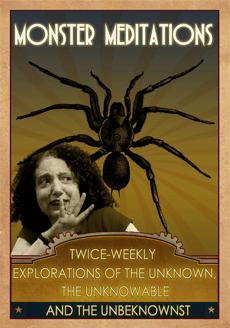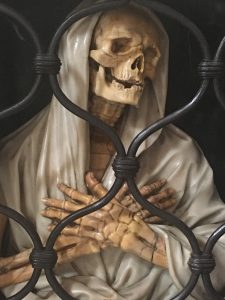Skeletons, caskets, crypts, graveyards, ruins, funerary images, death masks, death scenes, tombstones, plague doctor masks, and more… Is it all too morbid or is it just a lost part of life?
Is death different in the 21st Century? It is not as omnipresent as it was for past generations. It’s not that death has disappeared; it’s more that death is removed, ritualized, and restricted. Modern medicine isolates death and makes it more unusual (good) and more monumental (maybe not so good) as people struggle to face their own mortality and the loss of love ones. It’s confusing. We want to feel that we are enlightened and rational, but sometimes I think we’re just scared.
In the past, death was a daily reality. Many ancient religions are commonly described as ‘death cults’ with a focus on the afterlife at the expense of the day-to-day experiences of people with short life expectancies. The Christian emphasis on the rewards awaiting good people in heaven, and the drive, among the powerful, to leave a tangible legacy are both manifestations of a focus on mortality/immortality. Rome is full of concrete evidence of the lives of prominent Romans in the form of fountains, churches, palazzos, and monuments. Nothing says, “I’m immortal” like a visible legacy that withstands generations.
During my trip to Rome, I was walking around the city with its layers of ancient, medieval, gothic, baroque, modern, and contemporary life, all knitted together in a crazy tapestry. In the Villa Guila, I was struck by the objects Etruscans created to honor the dead; the bread & circuses in the Coliseum remind visitors that life can be brutish & short; in the many Catholic Churches death and everlasting life are painted, sculpted, and plastered in mosaics; and the Capuchin Monks decorated crypts with the skeletal remains of their brethren.
Death is everywhere all the time. It is part of life. And it tells millions of stories. Walking in the footsteps of all those waves of people is intimidating and inspiring. Rome is a great city for mystery writers.






I guess I definitely have a morbid streak because I’ll take pictures of dead birds when I come across them. I then doctor them up with photo apps to look even more disturbing. I have a thing for taking pictures of dead trees, too. Death is part of life, just like all else. On a semi-related note, I have joined the NextDoor social site for neighborhoods in my area, and a few weeks ago someone dumped some random wooden coffins in an alley. Nobody fessed up to doing it, but there’s a story in that scenario for sure. I also wonder if anyone went and got them so they could be used as free firewood?
I’m sure you could weave a wild story about those coffins! I know my brain is buzzing away… The dead bird photos——wow! I’m just too squeamish. But I do find myself drawn to the macabre in ART.
So much of art is about mortality—cheating death, embracing change, creating stories to avoid fear. I think it’s all part of being human.
I admit I’ve always hated death. I think it started when I was about eight. I’d found a sick kitten and tried to look after it in my Dad’s old tool shed. Vet bills were beyond us in those days so tlc was all I could offer. I think the poor little thing had feline enteritis or something. It really didn’t have a chance, but I was so sure I could save it through love and milk. So many decades later that one little death still hurts. And yet, I’ve come to recognize that without death, life would have no meaning. Why bother doing anything if you have all of eternity?
For myself, I’m glad that I have that goad to keep me writing. Atheist or no, I still want to leave some kind of legacy beyond ‘foo wuz ere’. 🙂
Yes… death——as the END——is a motivation to accomplish, to give to others, to leave something, anything, behind… It’s the ultimate ticking clock that tells us to DO NOW. It’s the last stage of the life cycle. Necessary & cruel.
I think the contemporary obsession with vampires (often those unhappy with the side effects of immortality) is rooted in our apprehension about death. Take death off the table and the math changes. You address that in Mira’s story. In fiction you can cheat death, do a work-around, at least for a time in a virtual place.